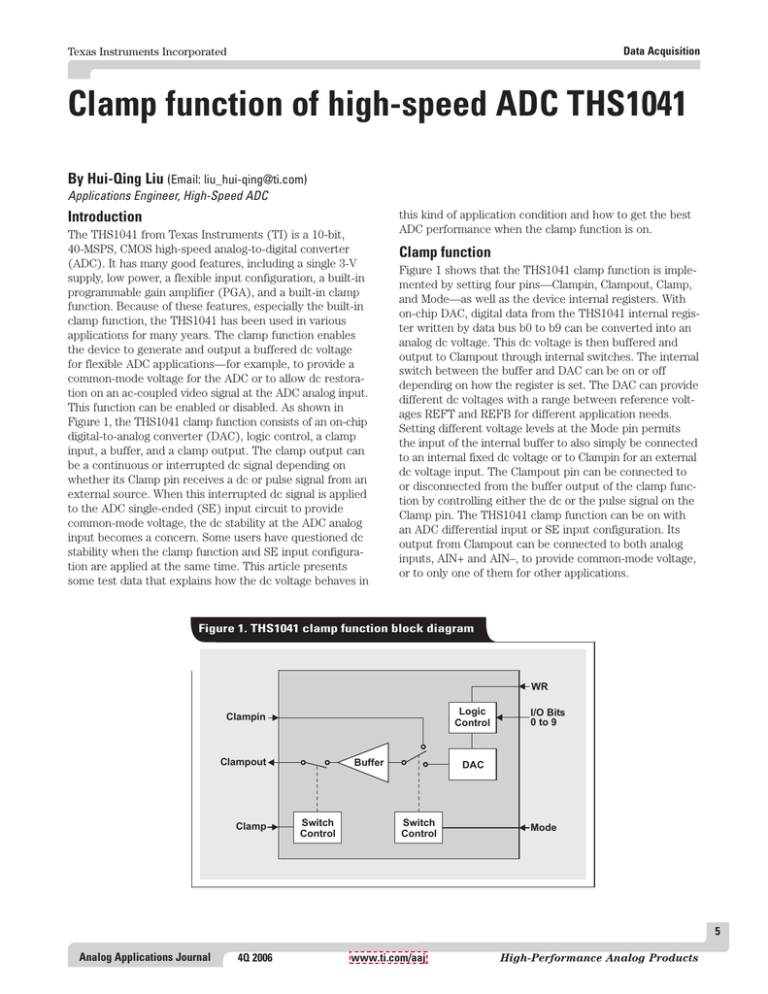Clamp function of high-speed ADC THS1041
advertisement

Data Acquisition Texas Instruments Incorporated Clamp function of high-speed ADC THS1041 By Hui-Qing Liu (Email: liu_hui-qing@ti.com) Applications Engineer, High-Speed ADC Introduction The THS1041 from Texas Instruments (TI) is a 10-bit, 40-MSPS, CMOS high-speed analog-to-digital converter (ADC). It has many good features, including a single 3-V supply, low power, a flexible input configuration, a built-in programmable gain amplifier (PGA), and a built-in clamp function. Because of these features, especially the built-in clamp function, the THS1041 has been used in various applications for many years. The clamp function enables the device to generate and output a buffered dc voltage for flexible ADC applications—for example, to provide a common-mode voltage for the ADC or to allow dc restoration on an ac-coupled video signal at the ADC analog input. This function can be enabled or disabled. As shown in Figure 1, the THS1041 clamp function consists of an on-chip digital-to-analog converter (DAC), logic control, a clamp input, a buffer, and a clamp output. The clamp output can be a continuous or interrupted dc signal depending on whether its Clamp pin receives a dc or pulse signal from an external source. When this interrupted dc signal is applied to the ADC single-ended (SE) input circuit to provide common-mode voltage, the dc stability at the ADC analog input becomes a concern. Some users have questioned dc stability when the clamp function and SE input configuration are applied at the same time. This article presents some test data that explains how the dc voltage behaves in this kind of application condition and how to get the best ADC performance when the clamp function is on. Clamp function Figure 1 shows that the THS1041 clamp function is implemented by setting four pins—Clampin, Clampout, Clamp, and Mode—as well as the device internal registers. With on-chip DAC, digital data from the THS1041 internal register written by data bus b0 to b9 can be converted into an analog dc voltage. This dc voltage is then buffered and output to Clampout through internal switches. The internal switch between the buffer and DAC can be on or off depending on how the register is set. The DAC can provide different dc voltages with a range between reference voltages REFT and REFB for different application needs. Setting different voltage levels at the Mode pin permits the input of the internal buffer to also simply be connected to an internal fixed dc voltage or to Clampin for an external dc voltage input. The Clampout pin can be connected to or disconnected from the buffer output of the clamp function by controlling either the dc or the pulse signal on the Clamp pin. The THS1041 clamp function can be on with an ADC differential input or SE input configuration. Its output from Clampout can be connected to both analog inputs, AIN+ and AIN–, to provide common-mode voltage, or to only one of them for other applications. Figure 1. THS1041 clamp function block diagram WR Logic Control Clampin Clampout Clamp Buffer Switch Control I/O Bits 0 to 9 DAC Switch Control Mode 5 Analog Applications Journal 4Q 2006 www.ti.com/aaj High-Performance Analog Products Data Acquisition Texas Instruments Incorporated Figure 2 shows a fundamental configuration of the THS1041 with the clamp function at the SE input. Setting Mode as AVDD/2 puts the device in an internal reference mode; and dc voltage at Clampout is from Clampin, not an internal DAC. The output of the clamp function, Clampout, is connected to AIN+ and also to a capacitor C2 through a small resistor R for a clamp pulse control application.1 Capacitor C2 is used to hold dc voltage when Clampout is disconnected internally during the clamp pulse interval. It is also used to couple ac signals from the source to AIN+. Another ADC analog input, AIN–, is connected to an external dc source and should have the same dc voltage as AIN+ for normal operation. The Clamp pin controls the internal switch between Clampout and the buffer output. When Clamp is logic high, Clampout is internally connected to the buffer output; and when Clamp is logic low, Clampout is disconnected from the buffer output. then the voltage at AIN– follows the voltage at AIN+. The dc voltages at AIN+ and AIN– drift toward each other after their voltage sources are disconnected. This is because significant charge or discharge occurs internally between the sampling capacitors in the ADC’s sample-andhold circuit during the hold phases after many clock cycles. The test data is shown in Tables 1 and 2. The test data in Tables 1 and 2, measured when the ADC clock was active, shows that disconnecting the analog input pins from the source makes their dc voltages affect each other. When the ADC clock is not running, the dc Table 1. Analog input dc voltage when clock is active and AIN– is connected to dc supply Clamp Logic Clampin (connected to dc supply) (V) AIN– (connected to dc supply) (V) Low High Low 1.5 1.5 1.5 1 1 1 Testing dc behavior with clamp dc control Clamp dc control means adding a dc signal at the Clamp pin to control the Clampout pin’s access to the internal buffer. To see dc behavior at AIN+ and AIN– when the clamp function is on, two different dc voltages are added to AIN+ and AIN–, and the logic level at Clamp is controlled manually. Based on the configuration in Figure 2, V2 is set at 1.5 V at Clampin, V1 is set at 1 V at AIN–, C2 is 0.6 µF, and R is 10 Ω. No ac signal is added to analog input AIN+ in this case. The ADC clock is running at 40 MHz. When Clamp is manually set to logic high (3 VDC), the AIN+ is stable at 1.5 V; and when Clamp is set to logic low (0 VDC), the AIN+ is stable at 1 V. In other words, when the Clamp pin is logic high, the voltage at AIN+ is driven by an internal buffer; and when the Clamp pin is logic low, AIN+ is disconnected from the buffer and its voltage drifts toward the voltage at AIN–. On the other hand, if AIN– is floating, AIN+ (charged or discharged based on Clamp logic) (V) 1 1.5 1 Table 2. Analog input dc voltage when clock is active and AIN– is floating Clamp Logic Clampin (connected to dc supply) (V) AIN– (charged or discharged) (V) Low High Low 1.5 1.5 1.5 0 1.5 0 AIN+ (charged or discharged based on Clamp logic) (V) 0 1.5 0 Figure 2. A clamp-mode configuration of THS1041 AIN– DC Supply V1 C2 AIN+ R ADC Core 50 Ω WR DC Supply V2 Clampin Logic Control Clampout Buffer I/O Bits 0 to 9 DAC C3 Clamp Source Clamp Switch Control Switch Control Mode = AVDD 2 6 High-Performance Analog Products www.ti.com/aaj 4Q 2006 Analog Applications Journal Data Acquisition Texas Instruments Incorporated voltages at AIN+ and AIN– don’t affect each other (see Tables 3 and 4). In addition, whether or not capacitor C2 is used does not affect the dc voltage test result but does affect the transition time of the voltage change at AIN+. Figure 3. Spikes can appear at AIN+ with dc voltage on AIN– Clamp Pulse Table 3. Analog input dc voltage when clock is not active Clamp Logic Clampin (connected to dc supply) (V) AIN– (connected to dc supply) (V) Low High Low 1.5 1.5 1.5 1 1 1 AIN+ (charged or discharged based on Clamp logic) (V) 0 1.5 0* *Discharge slowly Table 4. Analog input dc voltage when clock is not active and AIN– is floating Clamp Logic Low High Low Clampin (connected to dc supply) (V) 1.5 1.5 1.5 AIN– (charged or discharged) (V) 0 0 0 AIN+ (charged or discharged) (V) 0 1.5 0* *Discharge slowly Testing dc behavior with clamp pulse control Clamp pulse control means adding a pulse signal at the Clamp pin to control the Clampout pin’s access to the internal buffer. To observe dc behavior at the THS1041 analog input, a pulse signal instead of a dc signal is added to the Clamp pin with a frequency of 16 kHz and a duty cycle of 6% (see Figure 2). Similar to the previous test, a fixed dc voltage of 1 V from a well decoupled supply is added to Clampin, and a variable dc voltage is added to AIN–. In this case, AIN+ is driven to 1 V by the internal buffer during the clamp pulse and is well maintained at that level by capacitor C2 during the clamp pulse interval when AIN– is 1 V. The capacitance C2 must be large enough and the clamp pulse interval short enough to keep the dc voltage at AIN+ the same level as the dc voltage at Clampin.1 However, the dc signal will be distorted if the dc offset at AIN– is set differently from AIN+. As mentioned earlier, the dc voltages at the analog input pins can drift when one pin or the other is floating. The test with clamp pulse control further proves this statement. The dc drift appears as a voltage spike when a pulse is applied to the Clamp pin, and this is observed by oscilloscope as shown in Figure 3. The spike periodically appears at AIN+ at clamp pulse frequency, and its amplitude increases as the dc voltage difference between the analog input pins increases. The test data shows that when Clampin is connected to a 1-V AIN+ with AIN– at 0.5 VDC AIN+ with AIN– at 1.5 VDC supply and AIN– is connected to a 0.5-V supply, the dc measurement at AIN+ is 1 V during the clamp pulse logic high and low. The ac measurement at AIN+ is a positive spike at about 20 mV and appears when the clamp pulse transitions from low to high. When AIN– is connected to a 1.5-V supply and Clampin is still connected to a 1-V supply, the dc measurement at AIN+ is 1 V. The ac measurement at AIN+ is a negative spike at about 30 mV and appears when the clamp pulse transitions from low to high. When AIN– is connected to a 1-V supply, the same as the dc voltage at AIN+, the spike disappears and the 1-V dc voltage at AIN+ is smooth and stable. Further testing shows that the spike gets smaller when the duty cycle of the clamp pulse goes higher. Adding a capacitor C3 at the Clampout pin will significantly limit the spike. THS1041 ac performance with clamp pulse control The spike at analog input AIN+ can degrade the ac performance of the THS1041 (see Figures 4 and 5 and Table 5). Figures 4 and 5 are FFT plots of the THS1041 with clamp pulse control and different dc voltage conditions on the analog input pins. The FFT plots are generated from a Labview FFT program based on the data captured from the THS1041 EVM by an HP1600 logic analyzer. The test signal at the analog input of the EVM is a 2.2-MHz sine wave with an amplitude of –20 dBFS (20 dB below the ADC’s full scale). It is generated from an HP8644 sine-wave generator and received by the SE input of the THS1041 through an onboard transformer. (Detailed settings of the EVM board for this test are described later in this article.) A pulse generator triggered by the HP8644 is running the THS1041 input clock at 40 MHz. The clamp pulse is generated from a pulse generator with a frequency of 15.6 kHz and a 50% duty cycle. In time domain the spike appears periodically at clamp pulse frequency as shown in Figure 3. In frequency domain the spike appears at 15.6 kHz (the low end of the frequency axis) on the FFT. When the dc voltage difference at the analog input pins is 0.5 V (AIN+ is 1 V and AIN– is 0.5 V), the spike at 15.6 kHz is –67 dBFS, the largest spike in the 7 Analog Applications Journal 4Q 2006 www.ti.com/aaj High-Performance Analog Products Data Acquisition Texas Instruments Incorporated FFT (see Figure 4). This spike is much higher than any harmonic on the FFT and contributes to the spurious-free dynamic range (SFDR) with a low value. When the dc voltage difference is zero (AIN+ and AIN– are 1 V), the spike at the same frequency is –82 dBFS, a 15-dB improvement (see Figure 5). This spike is lower than the second and third harmonics and lower than the total harmonic distortion (THD). Figures 4 and 5 show that with the dc voltage difference between AIN+ and AIN– increasing to a certain degree, the SFDR decreases and could be significantly worse than the THD if the input analog signal was small. This would Figure 4. FFT of THS1041 in clamp mode with 0.5-VDC difference between analog input pins Figure 5. FFT of THS1041 in clamp mode with 0-VDC difference between analog input pins 8 High-Performance Analog Products www.ti.com/aaj 4Q 2006 Analog Applications Journal Data Acquisition Texas Instruments Incorporated be especially true if the decoupling capacitance C3 at Clampout (see Figure 2) was not large enough. Based on these test results, a further test was conducted with a different decoupling capacitance at Clampout. With an analog input amplitude of –21 dBFS (21 dB below the 2-V full-scale input of the THS1041), a C3 value of 0.4 µF, and a dc voltage difference between AIN+ and AIN– of 0.5 V, the SFDR is about 16 dB worse than the THD. At the same value of C3, the SFDR is 3 dB worse than the THD when the dc voltage difference between AIN+ and AIN– is decreased to 0 V. If C3 is increased to 1.4 µF, the overall ac performance—including the SFDR, THD, and signal-tonoise ratio (SNR)—improves significantly. In this case the SFDR is about 5 dB better than the THD when the dc voltage difference between AIN+ and AIN– is zero, and about 6 dB worse than the THD when the dc voltage difference is 0.5 V. The test data is shown in Table 5. Table 5. THS1041 ac performance with different C3 values and different dc voltages at AIN– (clamp pulse is on and analog input is –21 dBFS) AIN+ (V) 1 1 1 AIN– (V) 0.5 1 1.5 SFDR Relative to THD (C3 = 0.4 µF) (dB) –16 –3 –17 SFDR Relative to THD (C3 = 1.4 µF) (dB) –6 5 –5 The test data shows that the dc voltage differences between AIN+ and AIN– cause not only a spike at the analog input but also early output saturation, therefore decreasing the maximum analog input amplitude. For example, when the dc voltage difference between AIN+ and AIN– is 0.5 V with AIN+ at 1 V, the maximum analog input amplitude has to be 20 dB below full scale to avoid output saturation. When the dc voltage difference is 0.3 V with AIN+ at 1 V, the maximum analog input amplitude is 3.5 dB below full scale. So the dc voltage at AIN+ and AIN– should be the same in order to maintain the best ac performance and the specified maximum input amplitude. The test data also shows that with the loss of maximum analog input amplitude, the THS1041 seems able to tolerate small dc voltage differences between AIN+ and AIN– to maintain the specified ac performance (see Table 6). In this test, the analog input sine wave is 2.2 MHz with 1.4 V peak to peak, 3.5 dB below the full scale of the THS1041. The sampling rate is 40 MHz, the clamp pulse is 16 kHz with a 6% duty cycle, and the dc voltage difference at the analog Table 6. THS1041 ac performance with SE input, clamp pulse control, and dc voltage difference of 0.3 V at analog input AIN+ AIN– dc Voltage dc Voltage (V) (V) 1 0.7 SNR (dBFS) 59 SFDR (dBc) 70 THD (dBc) 64 input is 0.3 V (AIN+ is 1 V and AIN– is 0.7 V). In this case, the ac performance is still within the specification, with SNR at 59 dBFS, SFDR at 70 dBc, and THD at 64 dBc. Test setup conditions This ac performance test was based on the THS1041 EVM board. The EVM schematic is shown in Reference 2. The basic SE configuration of the EVM is similar to that of Figure 2. C2 is 0.6 µF, C3 is 1.4 µF, and the dc source at AIN– is well decoupled from a 3.3-V supply. On the EVM board, pin 1 of T1 (transformer) is open for SE input, and J2 is the analog input. The jumpers for pins 1 to 2 are on at W1 and W2, the jumper for pins 1 to 2 is off at SJP6, and the jumpers for pins 1 to 2 are on at SJP2 and SJP1. Conclusion To maintain the maximum input range and best ac performance of the THS1041, the common-mode voltages added to analog inputs AIN+ and AIN– should meet the requirement in the datasheet, and the dc voltage added to AIN– should be the same as the dc voltage at AIN+ with an SE input configuration. Adding different dc voltages to AIN+ and AIN– can cause a spike at the analog input when the clamp function is on and a pulse signal is applied to Clamp. The higher the dc voltage difference between analog inputs AIN+ and AIN–, the larger the spike. The spike also gets worse if the duty cycle of the clamp pulse is decreased. This is because the dc voltages at AIN+ and AIN– drift toward each other after their external voltage sources are disconnected. In this case the charge or discharge occurs internally between the sampling capacitors in the ADC’s sample-and-hold circuit during the hold phases. The dc voltage difference between AIN+ and AIN– also causes early output saturation and degrades the maximum analog input amplitude, so the difference should be limited. Increasing decoupling capacitance at Clampout will minimize the spike, increase dc voltage difference tolerance at the analog input, and improve overall THS1041 ac performance. This conclusion is based on the THS1041 bench test. The observation and test method in this article are also helpful for other high-speed ADCs. References For more information related to this article, you can download an Acrobat Reader file at www-s.ti.com/sc/techlit/ litnumber and replace “litnumber” with the TI Lit. # for the materials listed below. Document Title TI Lit. # 1. “10-Bit, 40-MSPS Analog-to-Digital Converter with PGA and Clamp,” THS1041 Datasheet . . .slas289 2. “THS1040/41 Evaluation Module for the THS1040/THS1041 10-Bit ADC,” User’s Guide .slau079 Related Web sites Input Amp (dBFS) –3.5 dataconverter.ti.com www.ti.com/sc/device/THS1040 www.ti.com/sc/device/THS1041 9 Analog Applications Journal 4Q 2006 www.ti.com/aaj High-Performance Analog Products IMPORTANT NOTICE Texas Instruments Incorporated and its subsidiaries (TI) reserve the right to make corrections, modifications, enhancements, improvements, and other changes to its products and services at any time and to discontinue any product or service without notice. Customers should obtain the latest relevant information before placing orders and should verify that such information is current and complete. All products are sold subject to TI's terms and conditions of sale supplied at the time of order acknowledgment. TI warrants performance of its hardware products to the specifications applicable at the time of sale in accordance with TI's standard warranty. Testing and other quality control techniques are used to the extent TI deems necessary to support this warranty. Except where mandated by government requirements, testing of all parameters of each product is not necessarily performed. TI assumes no liability for applications assistance or customer product design. Customers are responsible for their products and applications using TI components. To minimize the risks associated with customer products and applications, customers should provide adequate design and operating safeguards. TI does not warrant or represent that any license, either express or implied, is granted under any TI patent right, copyright, mask work right, or other TI intellectual property right relating to any combination, machine, or process in which TI products or services are used. Information published by TI regarding third-party products or services does not constitute a license from TI to use such products or services or a warranty or endorsement thereof. Use of such information may require a license from a third party under the patents or other intellectual property of the third party, or a license from TI under the patents or other intellectual property of TI. Reproduction of information in TI data books or data sheets is permissible only if reproduction is without alteration and is accompanied by all associated warranties, conditions, limitations, and notices. Reproduction of this information with alteration is an unfair and deceptive business practice. TI is not responsible or liable for such altered documentation. Resale of TI products or services with statements different from or beyond the parameters stated by TI for that product or service voids all express and any implied warranties for the associated TI product or service and is an unfair and deceptive business practice. TI is not responsible or liable for any such statements. Following are URLs where you can obtain information on other Texas Instruments products and application solutions: Products Amplifiers Data Converters DSP Interface Logic Power Management Microcontrollers amplifier.ti.com dataconverter.ti.com dsp.ti.com interface.ti.com logic.ti.com power.ti.com microcontroller.ti.com Applications Audio Automotive Broadband Digital control Military Optical Networking Security Telephony Video & Imaging Wireless www.ti.com/audio www.ti.com/automotive www.ti.com/broadband www.ti.com/digitalcontrol www.ti.com/military www.ti.com/opticalnetwork www.ti.com/security www.ti.com/telephony www.ti.com/video www.ti.com/wireless TI Worldwide Technical Support Internet TI Semiconductor Product Information Center Home Page support.ti.com TI Semiconductor KnowledgeBase Home Page support.ti.com/sc/knowledgebase Product Information Centers Americas Phone Internet/Email +1(972) 644-5580 Fax support.ti.com/sc/pic/americas.htm Europe, Middle East, and Africa Phone Belgium (English) +32 (0) 27 45 54 32 Netherlands (English) Finland (English) +358 (0) 9 25173948 Russia France +33 (0) 1 30 70 11 64 Spain Germany +49 (0) 8161 80 33 11 Sweden (English) Israel (English) 180 949 0107 United Kingdom Italy 800 79 11 37 Fax +(49) (0) 8161 80 2045 Internet support.ti.com/sc/pic/euro.htm Japan Fax International Internet/Email International Domestic Asia Phone International Domestic Australia China Hong Kong India Indonesia Korea Fax Internet +81-3-3344-5317 Domestic +1(972) 927-6377 +31 (0) 546 87 95 45 +7 (4) 95 98 10 701 +34 902 35 40 28 +46 (0) 8587 555 22 +44 (0) 1604 66 33 99 0120-81-0036 support.ti.com/sc/pic/japan.htm www.tij.co.jp/pic +886-2-23786800 Toll-Free Number 1-800-999-084 800-820-8682 800-96-5941 +91-80-41381665 (Toll) 001-803-8861-1006 080-551-2804 +886-2-2378-6808 support.ti.com/sc/pic/asia.htm Malaysia New Zealand Philippines Singapore Taiwan Thailand Email Toll-Free Number 1-800-80-3973 0800-446-934 1-800-765-7404 800-886-1028 0800-006800 001-800-886-0010 tiasia@ti.com ti-china@ti.com C062706 Safe Harbor Statement: This publication may contain forwardlooking statements that involve a number of risks and uncertainties. These “forward-looking statements” are intended to qualify for the safe harbor from liability established by the Private Securities Litigation Reform Act of 1995. These forwardlooking statements generally can be identified by phrases such as TI or its management “believes,” “expects,” “anticipates,” “foresees,” “forecasts,” “estimates” or other words or phrases of similar import. Similarly, such statements herein that describe the company's products, business strategy, outlook, objectives, plans, intentions or goals also are forward-looking statements. All such forward-looking statements are subject to certain risks and uncertainties that could cause actual results to differ materially from those in forward-looking statements. Please refer to TI's most recent Form 10-K for more information on the risks and uncertainties that could materially affect future results of operations. We disclaim any intention or obligation to update any forward-looking statements as a result of developments occurring after the date of this publication. Trademarks: All trademarks are the property of their respective owners. Mailing Address: Texas Instruments Post Office Box 655303 Dallas, Texas 75265 © 2006 Texas Instruments Incorporated SLYT253




